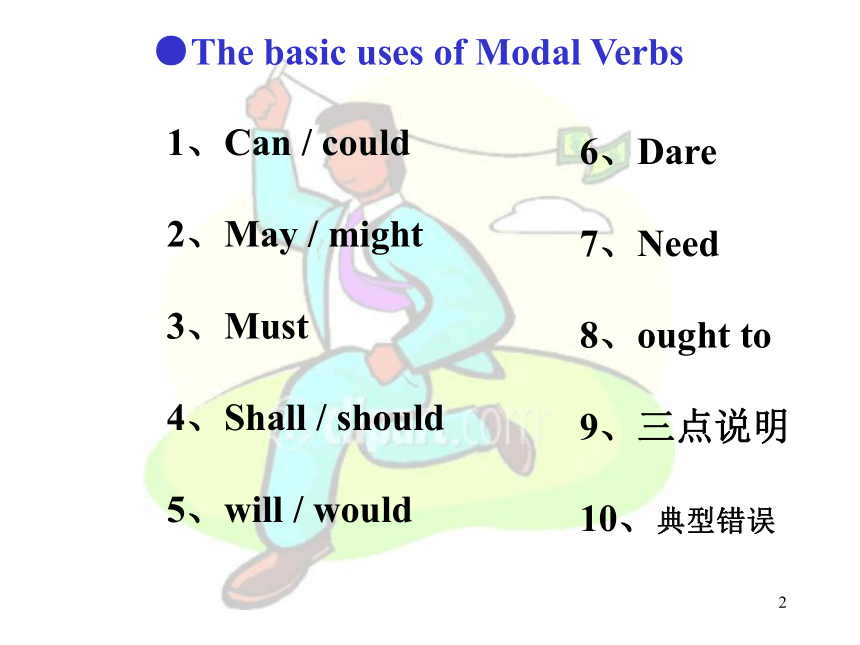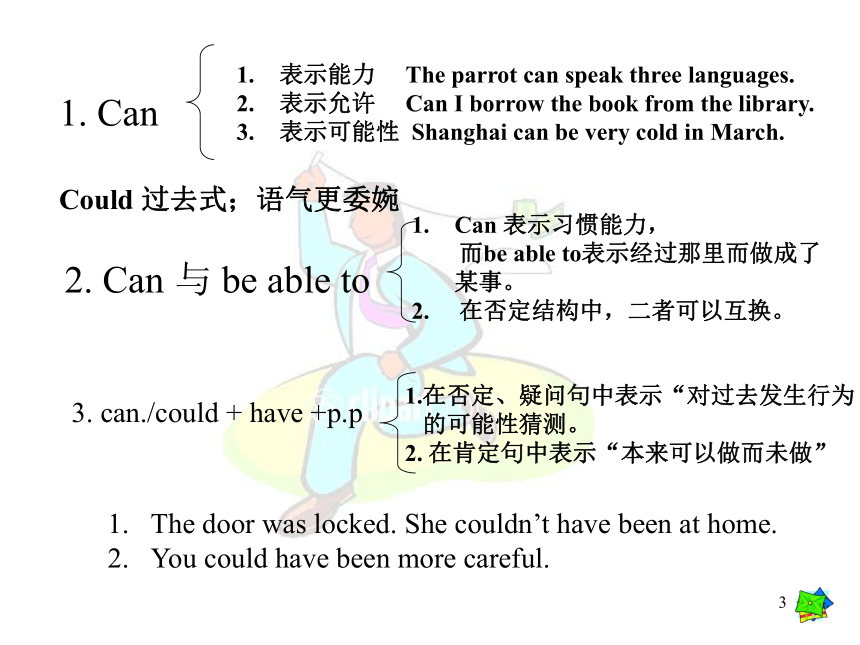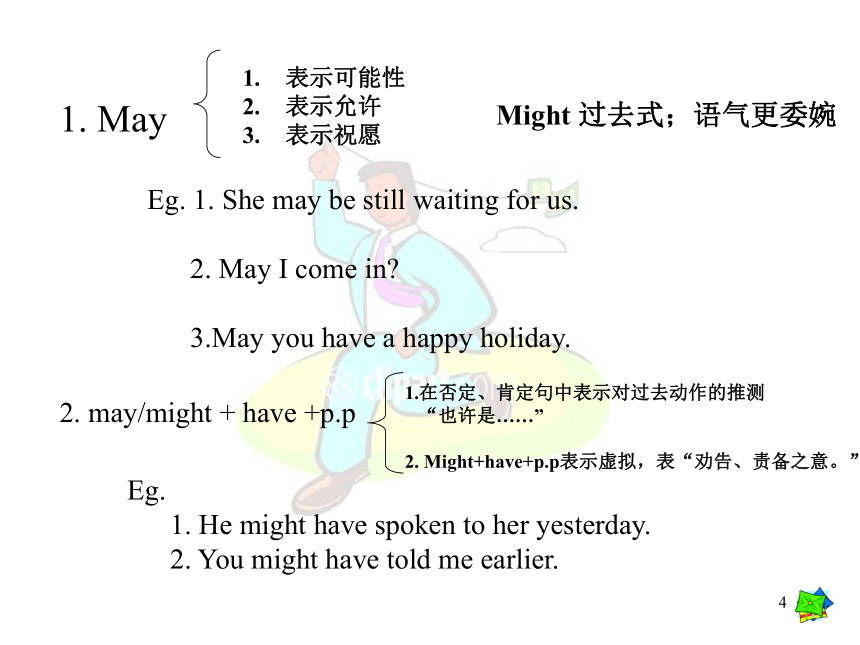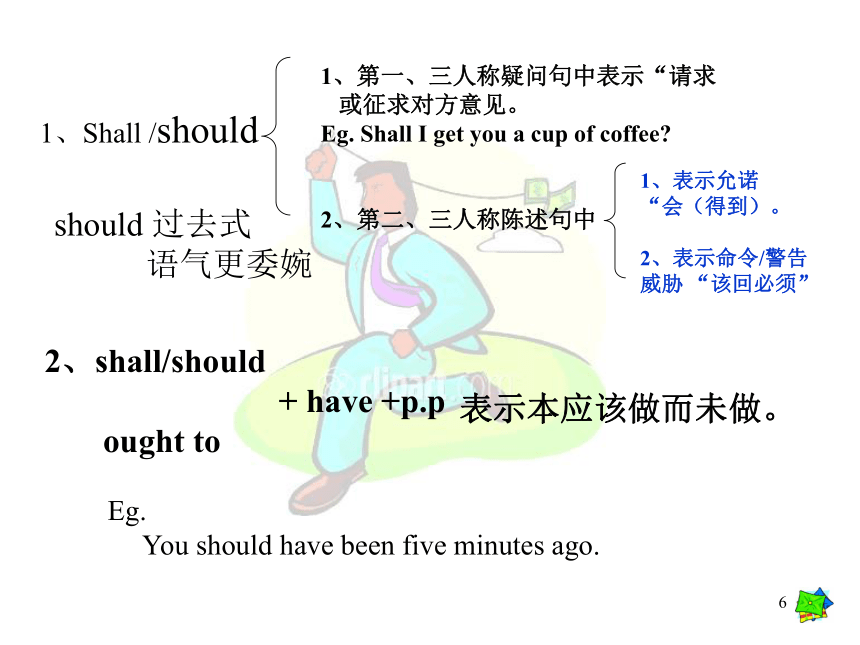情态动词
图片预览






文档简介
课件12张PPT。Revision for Modal Verbs 1●The basic uses of Modal Verbs 11. Can Could 过去式;语气更委婉Can 表示习惯能力,
而be able to表示经过那里而做成了某事。
2. 在否定结构中,二者可以互换。1.在否定、疑问句中表示“对过去发生行为
的可能性猜测。
2. 在肯定句中表示“本来可以做而未做”The door was locked. She couldn’t have been at home.
You could have been more careful.11. May Might 过去式;语气更委婉1.在否定、肯定句中表示对过去动作的推测
“也许是……”
2. Might+have+p.p表示虚拟,表“劝告、责备之意。”Eg. 1. She may be still waiting for us.
2. May I come in?
3.May you have a happy holiday.Eg.
1. He might have spoken to her yesterday.
2. You might have told me earlier.11. Must 表示肯定的猜测,但只用于肯定句,
而mustn’t 表示“禁止、不准”Must表示主观
Have to表示客观需求
Have got to 多见于口语3. must + have +p.p对过去事情的肯定猜测。Eg.
The road id wet. It must have rained last night.11、Shall /should 2、shall/should
+ have +p.p
ought to表示本应该做而未做。should 过去式
语气更委婉Eg.
You should have been five minutes ago.1Will/ would 1、Would 后只能接表示动作的动词。2、used to 则还可以接表示状态的动词。
Eg.
He used to be a worker.11、情态动词用于否定、疑问句;条件从句中。
eg.
1. Dare you go here alone?
2. How dare you do such follish things?
3. I won’t allow you to swim in the river,
even if you dare do it.Dare / dared2 、做实意动词后加不定式。
eg.
I have never dared to tell him about it.1Need /needed 1、情态动词用于否定句,疑问句。2、实意动词用法似dare,用作不定式。3、need + not + have +p.p
表示“本来不需要做而做了。1Ought to 1、其否定式为ought not to2、ought to + have + p.p
表示本来应该做而没有做到。Eg.
You ought not to have cut away the trees around the old building.1三点说明1、情态动词 + v 表示对现在或将来动作的猜测。
情态动词 + have + p.p表示对过去动作的猜测。2、情态动词的过去式与原形相比,多点礼貌,少点冒昧,
语气更为委婉。情态动词在一般疑问句中的回答:
① Can you sing?
② May I come in?
③ Must I handin the book now?
④ Need I finish it now?1典型错误1. He mustn’t be in the classroom. ( )Can’t2. You might leave the bag on the bag. ( )might have left3. You must have seen the film last week, have’t you?
( )didn’t you 4. Li ming must have been to Japan, didn’t he? ( )hasn’t he1
而be able to表示经过那里而做成了某事。
2. 在否定结构中,二者可以互换。1.在否定、疑问句中表示“对过去发生行为
的可能性猜测。
2. 在肯定句中表示“本来可以做而未做”The door was locked. She couldn’t have been at home.
You could have been more careful.11. May Might 过去式;语气更委婉1.在否定、肯定句中表示对过去动作的推测
“也许是……”
2. Might+have+p.p表示虚拟,表“劝告、责备之意。”Eg. 1. She may be still waiting for us.
2. May I come in?
3.May you have a happy holiday.Eg.
1. He might have spoken to her yesterday.
2. You might have told me earlier.11. Must 表示肯定的猜测,但只用于肯定句,
而mustn’t 表示“禁止、不准”Must表示主观
Have to表示客观需求
Have got to 多见于口语3. must + have +p.p对过去事情的肯定猜测。Eg.
The road id wet. It must have rained last night.11、Shall /should 2、shall/should
+ have +p.p
ought to表示本应该做而未做。should 过去式
语气更委婉Eg.
You should have been five minutes ago.1Will/ would 1、Would 后只能接表示动作的动词。2、used to 则还可以接表示状态的动词。
Eg.
He used to be a worker.11、情态动词用于否定、疑问句;条件从句中。
eg.
1. Dare you go here alone?
2. How dare you do such follish things?
3. I won’t allow you to swim in the river,
even if you dare do it.Dare / dared2 、做实意动词后加不定式。
eg.
I have never dared to tell him about it.1Need /needed 1、情态动词用于否定句,疑问句。2、实意动词用法似dare,用作不定式。3、need + not + have +p.p
表示“本来不需要做而做了。1Ought to 1、其否定式为ought not to2、ought to + have + p.p
表示本来应该做而没有做到。Eg.
You ought not to have cut away the trees around the old building.1三点说明1、情态动词 + v 表示对现在或将来动作的猜测。
情态动词 + have + p.p表示对过去动作的猜测。2、情态动词的过去式与原形相比,多点礼貌,少点冒昧,
语气更为委婉。情态动词在一般疑问句中的回答:
① Can you sing?
② May I come in?
③ Must I handin the book now?
④ Need I finish it now?1典型错误1. He mustn’t be in the classroom. ( )Can’t2. You might leave the bag on the bag. ( )might have left3. You must have seen the film last week, have’t you?
( )didn’t you 4. Li ming must have been to Japan, didn’t he? ( )hasn’t he1
